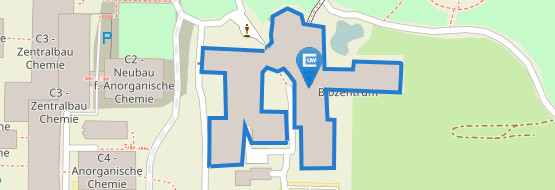Exciting Plant Vacuoles
06/14/2019Researchers have filled two knowledge gaps: The vacuoles of plant cells can be excited and the TPC1 ion channel is involved in this process. The function of this channel, which is also found in humans, has been a mystery so far.

Many plant processes are not different from humans: Cells and tissues in grain plants, including maize also communicate through electrical signals. The shape and frequency of these signals tell a plant different things. For example, it allows them to respond to heat and cold, excessive light intensities or insect pests.
If, for instance, a caterpillar starts to nibble on the leaves of a wild plant, an electrical signal is sent to the leaves that haven't been harmed yet, triggering a response mechanism: Bitter agents or toxic substances are subsequently produced throughout the plant, causing the caterpillar to stop eating or killing it after a while. But the ability to produce bitter substances has been bred out of modern crops for reasons of taste. Therefore, chemical pesticides are sprayed on field crops to rid them of caterpillar pests.
Researchers from the Julius-Maximilians-Universität (JMU) Würzburg in Bavaria, Germany, have now shed new light on plant communication via electrical signals. They found out that the TPC1 ion channel contributes to plant excitability. The function of this channel had been previously unknown. This discovery may pave the way to breed plants that are more resistant to pests, heat or drought in the long run – properties that are crucial in the face of climate change.
Publication in Nature Communications
The JMU scientists led by biophysicist Professor Rainer Hedrich have now presented their findings in the renowned journal "Nature Communications". It was Hedrich who had discovered the TPC1 ion channel in the mid-1980s, when he was a postdoc with Nobel Laureate Erwin Neher in Göttingen. Over the years, he has thoroughly studied the channel and described almost all of its properties.
Hedrich's new paper fills another knowledge gap. The cell membranes of plants were already known to be excitable; the scientists have now proved that this also applies to the membrane which encloses the central vacuole of the plant cells – and TPC1 plays a key role here as well. The vacuole is an enclosed compartment filled with an aqueous solution that can take up as much as 90 percent of the volume of a plant cell. Its main purpose is that of a pantry for storing nutrients.
Electrical signal concurrent with calcium wave
How do electrical signals in the membrane of the vacuole develop? When a leaf is wounded, a calcium wave is triggered in the injured leaf in addition to the electrical signal. "The two signals are mutually reinforcing, allowing the signal to propagate throughout the plant," explains Ingo Dreyer, a professor at the University of Talca in Chile and a collaborator of Hedrich.
In plants with a defective TPC1, the calcium wave travels more slowly or not at all. "This finding led us to study the properties of the vacuole using the patch clamp technique," Hedrich says. It turned out that vacuoles lacking TPC1 cannot be excited, neither by an electric charge nor by a calcium boost. In a hyperactive mutant of TPC1, however, the excitation was sustained. "This technique and other analyses have enabled us to mathematically model vacuolar behaviour and predict yet unknown properties of the vacuole channels," Dreyer says.
Investigating the structure and functioning of the ion channel
"Our discovery is also of interest for medical research," Hedrich says. This is because relatives of the TPC1 channel have also been identified in humans. But it is not fully known yet which role the channel plays in the tiny membrane vesicles, the endosomes of our cells. Therefore, medical researchers are also looking for common features in the structure and function of TPC1 in plants and humans.
"To provide answers, US scientists conducted X-ray structural analyses for our patch clamp measurements to determine the molecular blueprint underlying the channel function. This makes TPC1 one of the best understood, voltage-dependent ion channels," the JMU professor says.
TPC1 consists of two identical subunits. When they assemble to form a pair, a complex is created that has an ion channel at its centre which responds to voltage and calcium ions. There is a calcium receptor in the cytoplasmic end of TPC1 to activate the channel and another receptor on the inside of the vacuole. If the internal calcium concentration becomes too high, the channel is blocked and the vacuole loses its excitability.
TPC1 in evolution and climate change
"We also asked ourselves when the calcium-dependent TPC1 functions occurred in plants for the first time," Hedrich says. Mosses were evidently the first to do so. "Now we aim to find out whether TPC1 is also responsible for the excitability in early ancestors of our crops and whether implanting alga or moss TPC1 is capable of healing the functional failure in mutants of modern crop plants."
Moreover, the researchers discovered that there are plant families whose members exhibit significant differences in the development of the individual channel functions. They now want to understand the reason for these differences at the molecular level. Moreover, they intend to check whether the minor differences facilitate plant stress adaptation.
Publication
"Voltage-dependent gating of SV channel TPC1 confers vacuole excitability“ Dawid Jaślan, Ingo Dreyer, Jinping Lu, Ronan O’Malley, Julian Dindas, Irene Marten, Rainer Hedrich. Nature Communications, 14 June 2019, DOI: 10.1038/s41467-019-10599-x
Contact
Prof. Dr. Rainer Hedrich, Chair of Botany I (Plant Physiology and Biophysics), University of Würzburg, T: +49 931 31-86100, hedrich@botanik.uni-wuerzburg.de






